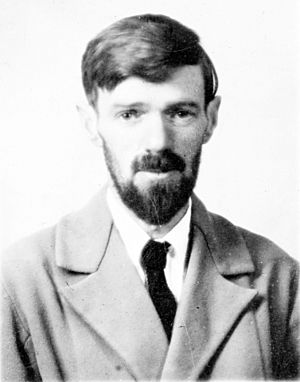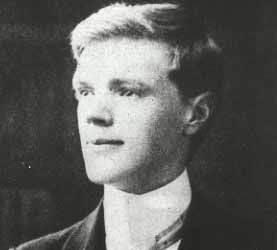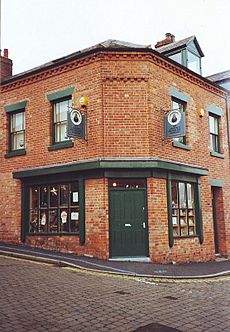D.H. Lawrence facts for kids
Quick facts for kids
D. H. Lawrence
|
|
|---|---|
 |
|
| Born | David Herbert Lawrence 11 September 1885 Eastwood, Nottinghamshire, England |
| Died | 2 March 1930 (aged 44) Vence, France |
| Resting place | D. H. Lawrence Ranch, Taos, New Mexico |
| Occupation | Novelist, poet |
| Nationality | British |
| Alma mater | University College Nottingham |
| Period | 1907–1930 |
| Genre | Modernism |
| Notable works |
|
David Herbert Lawrence (born September 11, 1885 – died March 2, 1930) was an English writer and poet. He is known for his novels, short stories, poems, and essays. Lawrence often wrote about how people relate to each other and the world around them.
Contents
Life and Career of D. H. Lawrence
Growing Up in Eastwood
David Herbert Lawrence was born in Eastwood, Nottinghamshire, England. He was the fourth child in his family. His father worked as a miner, and his mother had been a teacher. The house where he was born is now the D. H. Lawrence Birthplace Museum.
Lawrence grew up near coal mines, but he also loved exploring the open countryside. He often wrote about nature and the places he knew from his childhood. These early experiences shaped many of his stories.
He went to Beauvale Board School and later won a scholarship to Nottingham High School. After school, he worked briefly but became very sick with pneumonia. During his recovery, he became good friends with Jessie Chambers, who later inspired characters in his books. They both loved reading, which was important to Lawrence throughout his life.
From 1902 to 1906, Lawrence worked as a student teacher. He then studied at University College, Nottingham, and became a certified teacher in 1908. During these years, he started writing his first poems and stories. He even won a short story competition in 1907.
Starting His Writing Career
In 1908, Lawrence moved to London to teach. He kept writing in his free time. A friend sent some of his early poems to Ford Madox Ford, a famous editor. This led to Lawrence publishing his story Odour of Chrysanthemums. Soon, a publisher asked him for more work, and his career as a professional writer began.
In 1910, his first novel, The White Peacock, was published. Sadly, his mother died that same year, which was a very difficult time for him.
In 1912, Lawrence met Frieda Weekley. She was six years older and married with three children. Despite this, they fell in love and left England together. They traveled through Germany and Italy. In Germany, Lawrence was briefly mistaken for a British spy.
Their travels inspired his first travel book, Twilight in Italy. They also wrote the first drafts of two famous novels, The Rainbow and Women in Love. These books were quite new for their time and caused a lot of discussion.
Frieda eventually got a divorce, and she and Lawrence married in 1914, just before World War I began. Because Frieda was German and Lawrence didn't like war, they faced many challenges and were very poor during the war years in Britain. They were often viewed with suspicion.
In 1917, Lawrence was forced to leave Cornwall due to wartime rules. He moved around England for a few years, living in different small villages. He also got very sick with the flu but recovered.
Years of Travel and Exile
After the war, Lawrence decided to leave Britain. He called this time his "savage pilgrimage" because he traveled so much. He only returned to England twice for short visits. He and Frieda traveled all over the world, including Italy, Sri Lanka, Australia, the United States, Mexico, and the South of France.
Many of these places appear in his writings. Lawrence is known as one of the best travel writers in English. For example, Sea and Sardinia describes his journey to Sardinia in 1921.
Later Life and Works
In 1922, the Lawrences left Europe for the United States. On their way, they stopped in Ceylon (now Sri Lanka) and Australia. In Australia, Lawrence worked with a local writer, Mollie Skinner, on the novel The Boy in the Bush. He also finished Kangaroo, a novel that explored his wartime experiences.
While in the U.S., Lawrence wrote and published Studies in Classic American Literature, a collection of essays. He also wrote new novels and short stories, such as The Plumed Serpent and St Mawr. He also wrote travel essays about Mexico called Mornings in Mexico.
In 1925, while visiting Mexico, Lawrence became very sick with malaria and tuberculosis. Although he recovered, his illness meant he had to return to Europe. He was quite ill, which limited his travels for the rest of his life. The Lawrences settled in a villa near Florence, Italy.
During his final years, Lawrence became very interested in oil painting. He even had an exhibition of his paintings in London in 1929. However, his paintings caused some trouble, and the police stopped the exhibition and took some of his artworks.
Death of D. H. Lawrence
Lawrence continued to write even though his health was failing. He wrote many poems, reviews, and essays in his last months. His last major work was Apocalypse, a book reflecting on the Book of Revelation. He died on March 2, 1930, in Vence, France, from complications of tuberculosis.
Written Works
Short Stories
Lawrence wrote many well-known short stories. Some of his most famous include "The Captain's Doll", "The Fox", "The Rocking-Horse Winner", and "St Mawr". His collection The Prussian Officer and Other Stories was published in 1914.
Poetry
Lawrence wrote nearly 800 poems, most of them short. He started writing poetry in 1904. His poems changed a lot during his time in Cornwall, especially after World War I. He began writing in free verse, a style without a strict rhyme or rhythm, influenced by Walt Whitman.
His best-known poems often deal with nature. These can be found in his collection Birds, Beasts and Flowers, which includes famous poems like "Snake". After his death, two notebooks of his poems were published, including "Bavarian Gentians" and "The Ship of Death".
Plays
Lawrence also wrote several plays. A Collier's Friday Night was written around 1906–1909 but wasn't published until much later. He wrote The Daughter-in-Law in 1913, which was well-received when it was finally performed in 1967. Another play, The Widowing of Mrs. Holroyd, was first staged in the U.S. in 1916. His last play was David, written in 1925.
Painting
D. H. Lawrence had a lifelong interest in painting. It became one of his main ways to express himself in his later years. His paintings were shown at the Warren Gallery in London in 1929. Many artists and art experts praised his work. The largest collection of his paintings is now at the La Fonda de Taos hotel in Taos, New Mexico. Other paintings are held at the University of Texas at Austin.
Images for kids
See also
 In Spanish: D. H. Lawrence para niños
In Spanish: D. H. Lawrence para niños




